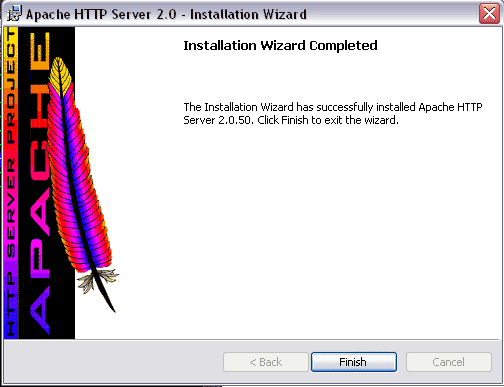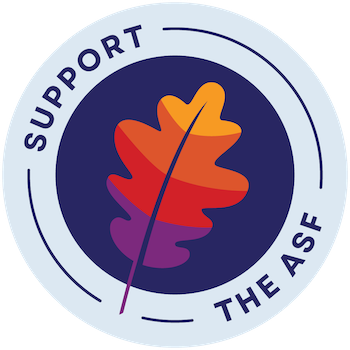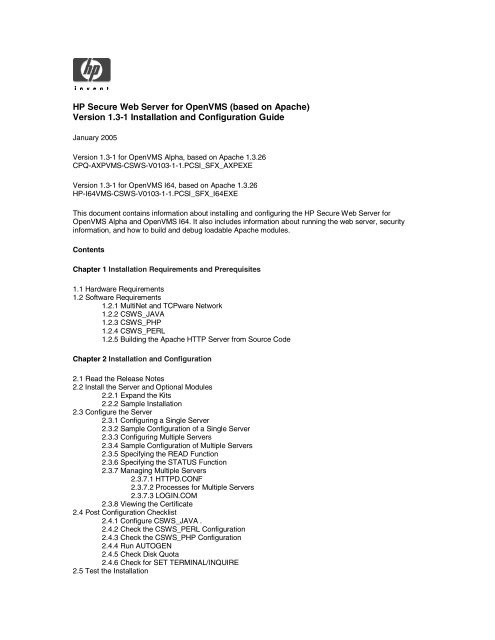Both web and application servers respond to user requests for content. Yet, there are several key differences between the two server types, and knowing these distinctions can help you configure the right software and hardware infrastructure for your needs.
Apache HTTP Server, colloquially known as Apache or httpd in Red Hat distributions is a free and opensource web server developed by Apache Software Foundation under Apache License version 2. Released in 1995, Apache has grown in leaps and bounds to become one of the most popular and widely used web servers, powering over 37% of all the websites. Apache is the most widely used Web Server application in Unix-like operating systems but can be used on almost all platforms such as Windows, OS X, OS/2, etc. The word, Apache, has been taken from the name of the Native American tribe ‘ Apache’, famous for its skills in warfare and strategy making. Apache Traffic Server™ software is a fast, scalable and extensible HTTP/1.1 and HTTP/2 compliant caching proxy server. Formerly a commercial product, Yahoo! Donated it to the Apache Foundation, and currently used by several major CDNs and content owners. Apache web server or Apache http server is one of the most widely used on the Internet. It is developed and maintained by Apache Software Foundation, Apache is an open source software available for free. Beside Apache, IIS and Nginx also among the most common web servers in use today. Learn to host your own website with Apache, a solid, well-known, and easy-to-configure web server.
Read on to learn the differences between web servers and application serversand their everyday use cases, and see which one is a better fit for your business needs.
App Server vs. Web Server: Key Differences
Here is an overview of the main distinctions between app and web servers:
| Web Servers | Point of Comparison | Application Servers |
| Hosts websites and responds to simple web requests | Main purpose | Hosts applications and delivers complex interactions through business logic |
| Only delivers static content via HTML | Type of content | Delivers static and dynamic content |
| HTTP/HTTPS protocols only | Protocols | The client-server interaction can occur via several protocols, including HTTP/HTTPS |
| No | Application connection | Yes |
| Has access to a static database | Database connection | Has access to the application database |
| Web browsers | Typical client | Serves web and mobile applications, and web browsers |
| Does not support multi-threading | Multi-threading | Uses multi-threading to process multiple requests in parallel |
| Facilitates traffic that does not consume a lot of resources | Resource consumption | Facilitates resource-intensive processes |
| Web container only | Containers | Web container (Servlets, JSP, JSF, web services), EJB container (JTA), Application Client container (DI, security) |
| Very low | Capacity | High |
| A hypertext document that displays information on a browser | Interaction result | Files that contain data and serve a specific purpose depending on the client needs |
What Is a Web Server?
Apache Web Server Tutorial
A web server is a computer system that stores, processes, and delivers web pages to clients. The client is almost always a web browser or a mobile application. Depending on the setup, a web server can store one or more websites.
This type of server only delivers static HTML content, such as:
- Documents
- Images
- Videos
- Fonts

Web servers and application servers have one thing in common - they need a dedicated server to run the software.
Traditionally, web servers do not deal with dynamic content or server-side programming. Web servers accept and fulfill Hypertext Transfer Protocol (HTTP or HTTPS) requests only. Optionally, you can add components for dealing with dynamic content.
What Is an Application Server?
An application server is a software framework that delivers content and assets for a client application. Clients include web-based applications, browsers, and mobile apps.
Application servers provide clients with access to business logic. Through business logic, an app server transforms data into dynamic content and enables the functionality of the application. Examples of dynamic content are:
- A transaction result
- Decision support
- Real-time analytics
This server type is the main link between a client and server-side code. Typical tasks of an application server include:
- Transaction management
- Security
- Dependency injection (DI)
- Concurrency
Application servers also handle processes such as clustering, fail-over, and load-balancing.
The Overlap Between Web and App Servers
When web browsers became the main application clients, the line between app and web servers got blurry.
Most web servers have plugins for scripting languages (ASP, JSP, PHP, Perl, etc.) that enable dynamic content generation. For example, if we add a .NET plugin to an IIS environment, we can connect the web server to server-side code and serve clients with dynamic content.
There is an overlap on the app server’s side too. Many application servers offer web server capabilities and use HTTP as a primary protocol.
Because of the overlap in use cases and technology, most popular servers are hybrids of the two types. A hybrid solution that combines server capabilities ensures optimal system speed and functionality.
For an inexpensive way of hosting a static website, consider using Object Storage.
Most Popular Web Servers
Here is an overview of the most popular web servers:
Nginx
Nginx is an open-source web server that can also act as a reverse proxy, email proxy, and load balancer. Nginx is event-driven, highly scalable, and can process multiple requests at the same time.
To get started with Nginx, refer to our guides How To Install Nginx On Ubuntu 20.04 or How To Install Nginx On CentOS 8.
Apache HTTP Server
The Apache HTTP server (also known only as Apache) is a free, open-source web server. Apache is a part of the LAMP stack, a software stack that powers around 40% of all websites on the Internet.
Apache offers a rich selection of features, including htaccess, IPv, FTP, HTTP/2, bandwidth throttling, and load balancing.
For an in-depth comparison of Nginx and Apache, read our article Nginx vs Apache.
Microsoft IIS
Microsoft IIS (Internet Information Services) is a free web server software package for Windows Server. IIS only runs on Windows operating systems.
Jetty
Jetty is an open-source project that provides an HTTP server, HTTP client, and a javax.servlet container. While primarily a web server, Jetty can also facilitate machine-to-machine communication.
LiteSpeed
LiteSpeed is a web server with excellent performance and scalability properties. LiteSpeed offers a wide range of features and has an easy-to-use web admin console.
Most Popular Application Servers
Here are the most wide-spread application servers on the market:
Apache Tomcat

Apache Tomcat is an open-source app server often used in conjunction with Apache HTTPD.
Tomcat can execute Java Servlets, deliver pages with JavaServer Page code, and serve Java EE (Java Enterprise Edition) apps.
If you are new to Tomcat, visit our tutorials How To Install Tomcat On Ubuntu or How To Install Tomcat On CentOS.
Oracle WebLogic
Oracle WebLogic Server is an application server for deploying distributed apps using Java EE standards. WebLogic is fully integrated with Oracle’s product and cloud service portfolio.


Glassfish
Glassfish is an open-source Java EE application server that supports Java Servlets and Enterprise JavaBeans (EJB). Glassfish can also function as a web server.
JBoss
JBoss application server is an open-source platform for building, deploying, and hosting Java applications. JBoss operates across platforms, and you can use it on any operating system that supports Java.
App Server vs. Web Server: Which One is the Right Server for Your Business?
Now that you understand the difference between web and application servers, it becomes easier to see which one is the better fit:
- Use a web server if you are serving static web pages only.
- Use a simpler application server like Jetty or Apache Tomcat if you have an application that requires JSP and Servlet.
- Use a full-blown application server like JBoss or Oracle WebLogic if you have an application with complex features like distributed transactions and messaging.
Another option is to use plugins to add functionalities to a web server. In that case, a web server can delegate dynamic response generation to a server-side technology option, such as CGI scripts, JSPs, Servlets, ASPs (Active Server Pages), or server-side JavaScript.

Using Both Server Types in the Same System
Apache Http Web Server Download
A popular setup is to deploy both a web server and an application server in the same system. This setup makes sense for websites that provide both static and dynamic content. In that case, the web server becomes a subset of the application server, and both services run on the same hardware.
Apache Http Web Server Vs Tomcat
The main reason for deploying both types of servers is improved system performance. Each server focuses on its strong points, and you prevent simple web requests from impacting application server performance.
As an example, consider an e-store that provides real-time pricing information. Such sites typically have a form with which a user can purchase products. When the user submits a query, the website does a lookup and returns the results set within an HTML page.
This functionality can operate with and without an application server.
Scenario 1: Using Only a Web Server with Plugins
The web server provides the e-store functionality:
- The server receives the request and passes it to a server-side program.
- The server-side program looks up the pricing data from a database or a flat-file.
- The server-side program formulates an HTML response.
- The web server sends the response back to the web browser.
Scenario 2: Using Both a Web Server and an Application Server
The application server stores the business logic for the pricing lookup. The web server delegates the response generation, but the script calls the application server’s lookup service and then formulates an HTML response.
By placing the pricing logic in the app server, the logic becomes reusable between different parts of the application. In our first scenario, the pricing lookup service is not reusable as data is embedded in an HTML page.
Conclusion
The overlap between application and web servers means that each use case has several valid solutions. Most systems can operate with a web server, app server, or a combination of the two.
However, not all setups are equally good. Knowing the differences between the two server types helps you save money, scale more easily, and choose a better fit for your use case.
Recent Posts
